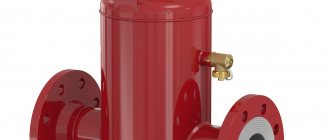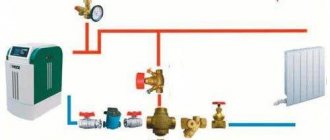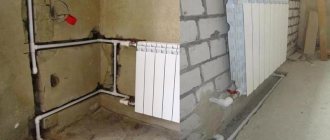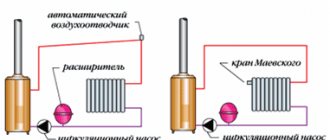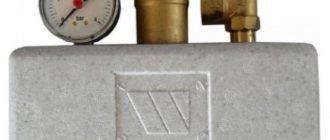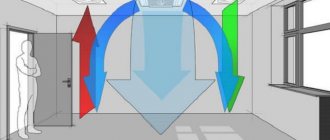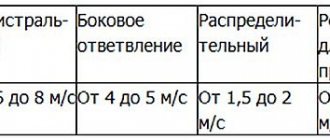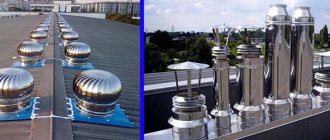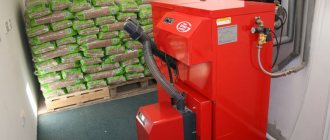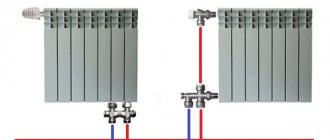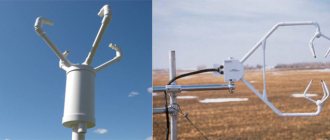How to determine the temperature of the exhaust gases of the chimney
The temperature of the exhaust gases can be determined in a simple way. To do this, place a dry splinter across the view hole during combustion. After 30-40 minutes, remove the splinter and scrape off the sooty surface.
- — If the color of the splinter does not change, it means the temperature is within 150C,
- - If the splinter turns yellow (to the color of a white bread crust), then the temperature reaches 200C,
- — The splinter turned brown (to the color of the crust of rye bread) — the temperature rose to 250C.
- — A blackened splinter indicates a temperature of 300C,
- — When a splinter turns into coal, the temperature reaches 400C.
When firing the furnace, the temperature of the gases must be adjusted so that at the view it is within 250. Cracks and holes in the pipe and furnace through which cold air penetrates also contribute to the cooling of the gases and the formation of condensation. When the cross-section of the pipe or chimney channel is higher than required, the flue gases rise through it slowly and the cold outside air cools them in the pipe. The surface of the chimney walls also has a great influence on the draft force: the smoother they are, the stronger the draft. Roughness in the pipe retains soot. and reduce cravings.
When firing the furnace, the temperature of the gases must be adjusted so that at the view it is within 250C. Cracks and holes in the pipe and furnace through which cold air penetrates also contribute to the cooling of the gases and the formation of condensation. When the cross-section of the pipe or chimney channel is higher than required, the flue gases rise through it slowly and the cold outside air cools them in the pipe. The surface of the chimney walls also has a great influence on the draft force: the smoother they are, the stronger the draft. Roughness in the pipe retains soot. and reduce cravings.
Hello, dear readers! My name is Vitaly Ivanovich, and I build stoves, fireplaces and install heating equipment.
For more than 40 years, starting back in 1977 as a stove maker’s assistant, I have been studying this business and improving my skills. With retirement I have more free time and I decided to share my experience with you. Read for good health and ask questions in the comments!
Source
Chimney for a boiler with natural draft
The movement of gas in the pipe under the influence of traction forces occurs due to the difference in the temperature of the gases at the inlet and outlet of the chimney. Hot gases in the chimney rush upward, creating a vacuum in the pipe.
Good draft in the chimney is a prerequisite for economical operation of the boiler with high productivity. This is especially important for the operation of a boiler with natural draft.
When installing a chimney for a boiler with natural draft, a number of general requirements must be met , which do not depend on what material the pipe is made of:
The chimney must be sealed ; cracks, crevices, and holes are not allowed.
It is necessary to ensure that the pipe is vertical and straight . If necessary, the chimney can be shifted to the side up to 1000 mm
.
at an angle of no more than 30 degrees
. to the vertical.
The surface inside the chimney must be smooth . Masonry seams must be thoroughly rubbed. Local contractions and expansions in the chimney should be avoided.
Below the junction of the chimney with the boiler, a hatch is made in the pipe for cleaning the pipe.
To limit the maximum draft into the pipe, in the path of the exhaust gases, install a damper if the boiler is not equipped with such a damper.
Sections of the chimney located outside the building must be insulated . In an uninsulated chimney, gases cool quickly. As a result, draft decreases, boiler power drops, and condensation forms on the pipe walls.
Special requirements for the chimney design are usually indicated in the technical documentation for the boiler. Before choosing a chimney, choose a boiler.
Find out the requirements for the boiler chimney system from the technical documentation.
The performance of the chimney is the amount of draft determined by the temperature of the exhaust gases and the size of the air channel of the pipe. The higher the temperature of the gases, the cross-section and height of the chimney pipe channel, the higher the amount of natural draft in the chimney.
Recommended chimney sizes for a modern boiler with a flue gas temperature of 250-450 °C.
| The minimum chimney height for a boiler with natural draft, depending on the power of the boiler and the size of the air channel of the pipe. |
Requirements for chimney material
Materials used for the production of smoke exhaust devices must meet the following requirements:
- Resistance to high temperatures;
- High resistance to corrosion;
- Resistance to aggressive chemicals and environments.
All these requirements for a chimney for a gas boiler have a real basis. Thus, the requirement for chemical inertness is due to the fact that in the chimney pipe during operation of a gas boiler there is a certain amount of condensate containing sulfuric acid. To ensure that such an environment does not damage the structure, it must be protected from corrosion and chemical attack. The intensity of condensation can be reduced by insulating the chimney.
Normal temperature of gases leaving the furnace
In order for the water present in hot gases to evaporate better, the temperature of the latter must be increased. On well-heated pipe walls, settled drops of moisture quickly evaporate.
The normal temperature of gases leaving the furnace before exiting into the pipe is 12O...14O°C, when leaving the pipe into the atmosphere - not lower than 100°C.
If the flue gases, when exiting into the chimney, that is, at the view, reach a temperature of about 250 ° C, then condensation does not form, draft improves, the stoves heat up faster, while consuming less fuel.
The temperature of the exhaust gases can be determined using a dry splinter, which is placed across the view hole during combustion. If after 30...40 minutes you remove the splinter and scrape off the sooty surface from it with a knife, you can set the temperature of the gases. The color of the splinter does not change at temperatures up to 150°C. If the torch turns yellow (to the color of a white bread crust), it means the temperature has reached 200°C;
Thus, when firing the furnace, the temperature of the gases must be adjusted so that at the viewer it is within 250°C.
How to reduce the temperature of flue gases in a chimney
The combustion of natural gas produces carbon dioxide, steam, sulfurous salt-forming oxides, etc. The optimal temperature of the flue gases at the chimney outlet should be 100–110 °C.
If the temperature of the flue gases is below the dew point, that is, the condensation temperature of the air, then the water vapor contained in the combustion products will settle on the walls of the chimney. If this happens constantly, the chimney can quickly collapse.
If the temperature of the flue gases is too low, condensation will form at the outlet of the chimney, and the outer part of the pipe will begin to freeze.
In addition, the presence of constant condensation in the smoke channel leads to a weakening of natural draft. Therefore, it is so important to monitor the temperature of the flue gases, which directly depends on the cross-section of the chimney.
From the above we can conclude that with correct calculation, the temperature of the flue gases will be in the region of optimal values. If the temperature is too high and needs to be reduced, this directly indicates that the cross-section of the chimney does not correspond to the power of the gas boiler. To reduce the temperature of the exhaust gases, it is recommended to reassemble the smoke exhaust system taking into account the standard values.
Choosing material for the chimney
When installing smoke exhaust systems, metal, ceramic and coaxial pipes can be used. You need to decide which pipe is needed for a gas boiler in accordance with the requirements of a particular boiler model. If the documentation does not contain such information, then you will have to study the characteristics of each of the presented materials.
The most popular material for making chimneys is metal. Stainless steel is most often used, but galvanized steel options are also available. In any case, the operating temperature in the chimney of a gas boiler when using metal pipes can reach 800 degrees, which is quite enough for arranging a combustion product removal system.
The design of metal chimneys includes an inner layer made of stainless steel, a thermal insulation layer made of basalt wool and a thin metal casing. Such devices are quite reliable, highly durable and have acceptable visual qualities.
The next option is ceramic chimneys, designed for operation at temperatures up to 1200 degrees. Such devices have a three-layer structure, which includes a ceramic layer, thermal insulation and an outer shell of expanded clay concrete. The main advantages of ceramic chimneys include simplicity of design and installation, reliability and high fire safety.
The last type of chimney is coaxial, which looks good and has very good performance characteristics. Thanks to the two-layer design, coaxial chimneys are reliably protected from condensate. In combination with gas boilers, this quality is especially pronounced, so choosing a coaxial chimney in this case will be the most justified.
There are also brick chimneys, but they are initially designed for use with solid fuel heating equipment. In order to be able to connect a gas boiler to a brick chimney, the latter must be converted by inserting a metal part into it and performing thermal insulation work.
For a solid fuel boiler - a brick chimney
A brick chimney is usually cheaper
than modern chimney systems.
A traditional ceramic brick chimney pipe can easily withstand high flue gas temperatures. The pipe can even withstand the ignition of soot accumulations in the chimney .
A brick chimney for a boiler in a private house is a rather heavy structure. The chimney is placed on a foundation or solid reinforced concrete floor. The construction of such a chimney requires certain skills; it is better to entrust the laying of a sealed and durable chimney to a qualified stove mason.
Channels and chimneys and ventilation are often placed in a brick chimney
The chimney is laid from high-quality solid ceramic bricks of a grade not lower than M125 using ordinary masonry mortar. The upper section of the pipe, above the roof, can be laid out of facing or clinker bricks. The thickness of the chimney walls must be at least 120 mm (half a brick).
Brick chimney laying. Ventilation ducts are usually placed next to the chimney in one vertical block. Templates make it easier to lay even channels with smooth walls.
The size of the chimney and ventilation channels is chosen as a multiple of the brick size, taking into account the thickness of the vertical joints. For example, the channel cross-section can be 140x140 mm (1/2x1/2 brick) or 140x200 mm (1/2x3/4 brick), or 140x270 mm (1/2 x 1 brick). In practice, a smoke channel is often made measuring 20 x 20 cm (3/4 x 3/4 bricks). If necessary, it is easy to select and insert a round steel or ceramic liner of the appropriate diameter into such a channel.
The flue gases in the chimney duct should not be very cool. Therefore, they try to build the chimney into the masonry of the internal wall of the house or attach it to the wall. Sections of the chimney that pass through an unheated room (attic) or outside the house are insulated with mineral wool .
A brick chimney serves reliably and for a long time only at high flue gas temperatures,
which prevents condensation from forming in the pipe. As a rule, this condition is met when the chimney is operated with a conventional solid fuel boiler.
When working with modern gas or liquid fuel boilers, as well as with solid fuel pyrolysis boilers, pellet and others, operating for a long time in a slow burning mode of low intensity, the brick chimney is destroyed quite quickly.
Modern boilers are designed so that the exhaust gases have a fairly low temperature. As a result, condensation of water vapor contained in the flue gases occurs in the chimney. The pipe walls are constantly moistened. In addition, when combining with other combustion products, water forms aggressive chemical compounds on the inner surface of the pipe.
In particular, the exhaust gases of boilers contain sulfur, which, interacting with water, forms sulfuric acid in the chimney, which corrodes its walls. External signs of destruction are dark wet spots on the outer surface of the brick pipe.
The operating mode of a solid fuel pyrolysis boiler also contributes to the formation of aggressive condensate in the chimney, which quickly destroys the brick chimney.
Rough chimney walls contribute to the accumulation of solid soot particles on them. The roughness of the walls and the rectangular shape of the chimney duct make it difficult to clean the chimney from deposits.
To connect gas and other boilers with low exhaust gas temperatures to a brick chimney, an insert must be placed in the brick channel - a steel or ceramic chimney pipe .
Types of systems
The design of sauna stoves includes 2 types of chimneys:
- Indigenous. They are organized next to the stove, using a special pipe for connection, through which the smoke goes into the main channel. One chimney can be used for 2-3 stoves. The main thing is that its internal diameter has the appropriate parameters, and the pipes from each heating device are located at different heights;
- Systems with a mounted pipe are mounted directly on the stove pipe and discharged through the roof. This chimney option is the most common for sauna stoves.
Dimensions and cross-section of the chimney
To calculate the cross-sectional area of the chimney pipe, you need to take into account the dimensions of the pipe that is in the gas boiler. As a result, the throughput of the chimney must be no less than the pipe itself. Two heating boilers can be connected to the chimney at once, but their inputs can only be placed at different levels, and the distance between them must be at least 0.5 m. The cross-section of the pipe when connecting two boilers is equal to the sum of their power multiplied by 5.5.
When figuring out what kind of chimney is needed for a gas boiler, you need to take into account not only its area, but also its cross-sectional shape. The cross-section of the chimney can be rectangular or round. The smoke flow moves inside the pipe along a spiral path, so the presence of different angles will interfere with it. It is because of this that it is advisable to give preference to a chimney with a round cross-section of pipes, which provide higher draft.
Use of wood based on its heat capacity
When choosing a type of firewood, it is worth considering the ratio of cost and heat capacity of a particular wood. As practice shows, the best option can be considered birch firewood, which has the best balance of these indicators. If you purchase more expensive firewood, the costs will be less effective.
To heat a house with a solid fuel boiler, it is not recommended to use types of wood such as spruce, pine or fir. The fact is that in this case, the combustion temperature of the wood in the boiler will not be high enough, and a lot of soot will accumulate on the chimneys.
Firewood made from alder, aspen, linden and poplar also has low thermal efficiency due to its porous structure. In addition, sometimes during the burning process alder and some other types of firewood shoot out coals. In the case of an open furnace, such micro-explosions can lead to fires.
It is worth noting that no matter what the wood is, if it is damp, it burns worse than dry wood and does not burn completely, leaving a lot of ash.
Pipe location
The chimney pipe can only be positioned vertically. The deviation from the vertical axis can be no more than 30 degrees, or 1 meter in any direction. The chimney is connected to the gas boiler in such a way that a pipe section of at least 0.5 m in length comes out of the boiler.
The number of bends and turns in the chimney should be kept to a minimum if possible. If this is not possible, then it is possible to install bends and elbows, but their total number should not exceed 3. Horizontal sections of pipes can have a slope of no more than 0.01 degrees towards the boiler.
Rules for installing a chimney for a gas boiler
When installing chimney pipes for a gas boiler in a private house, you need to follow a number of rules:
- Chimney elements must be installed from bottom to top;
- Structural elements can only be fastened vertically;
- The pipe for the gas boiler should not be higher than 5 m;
- Bends and sagging of pipes in straight sections are not allowed;
- All pipe connection points must be treated with sealant;
- The chimney should not have more than three horizontal sections longer than 1 m;
- The head can only be placed above the zone of passage of air masses.
Installation of a chimney according to the rules
Based on where the gas boiler will be located relative to the house, the chimney installation is carried out in two ways:
Indoors. Installing such a system is quite troublesome, and it is also necessary to strictly comply with fire safety requirements, because such a chimney has an increased risk of ignition or carbon monoxide leaking into the room. If all the rooms through which the chimney pipes pass are heated, then only the pipe located on the roof will need insulation. Please note that such a chimney is difficult to repair.
Coaxial pipe installation options
If you decide to install a chimney for a heating gas boiler yourself, then you first need to apply marks for drilling holes for the flue pipe in the ceiling and roof. Then double-check everything again, as they say: “measure seven times, cut once.” Cut out the opening. Now, let’s actually assemble the chimney:
- connect the heating boiler pipe to the adapter;
- Now you need to connect the tee and revision. After this, a sheet of steel is attached and the main holder is secured;
- we extend the gas outlet pipe from the bottom up, if necessary, use elbows;
- a special pipe is used in the place where the chimney crosses the floor of the house;
- Next, you need to throw a galvanized sheet over the chimney with a hole made in it, which is larger than the diameter of the chimney, and secure this sheet at the top and bottom of the ceiling;
- all places where gas outlet structures are joined must be additionally reinforced with clamps;
- We put a cap on the very top of the chimney - it will protect the chimney from bad weather.
Internal and external placement of the chimney
Outside. Due to the uniformity of the constituent elements of the chimney, it is easy to install and therefore easy to repair. Such a chimney requires thermal insulation along its entire length. If you are installing a chimney on the outside of the house, then the procedure is as follows:
- We mark the places for drilling openings and double-check. Then we thread the system passage through the drilled opening, one end of which is hermetically connected to the boiler pipe. The area that penetrates the wall is thermally insulated;
- we attach the revision and tee, then connect the plug;
- We install the flue elements from the bottom up. Don’t forget to attach the holders to the surface of the house;
- We reinforce all joints with clamps;
- Now you need to attach thermal insulation along the entire length of the chimney; this does not need to be done if you used a sandwich pipe.
Chimney installation methods
When installing a chimney, remember:
- all structural elements must be assembled correctly, gaps are unacceptable, and deflection of elements is also unacceptable;
- in places where the chimney crosses the structure of the house, it is necessary to install passage elements;
- The boiler and chimney are connected by applying heat-resistant sealant to the joints.
Advice. Thermal insulation of the chimney is performed with mineral wool, which is wrapped on top with foil or a sheet of galvanized steel. But there are ready-made products made from mineral materials on sale; you only need to measure the diameter and length of the pipe.
SNiP requirements for chimney installation
Any chimney, regardless of design features and material of manufacture, must be installed taking into account the requirements described in SNiP 2.04.05-91. The standards specified in this document are primarily aimed at creating a safe system. In addition, compliance with these standards will make it possible to put the boiler into operation and not have problems with the local gas service.
The installation of a gas boiler chimney in a private house must be carried out in accordance with a number of requirements:
- A chimney for gas heating equipment must provide good draft.
- The system must be arranged in such a way that it contains a condensate collector. This design helps prevent the destruction of the chimney, which occurs due to the accumulation of aggressive condensate on its walls.
- The chimney head must not be equipped with fungi, deflectors and similar devices that prevent the normal removal of gas combustion products.
- When installing a chimney, you must pay attention to the quality of fastening of individual elements. The entire structure must be assembled reliably enough to withstand operating conditions.
- The chimney of a gas boiler for heating a private house on each site must be sealed. Of course, we are talking about the points where the individual elements of the chimney are connected.
All chimney standards for a gas boiler are aimed at creating a high-quality system that can do its job.
How to check and adjust the draft in the chimney of a gas boiler
Draft is a decrease in pressure in the place where fuel combustion occurs. The pressure decrease occurs due to the removal of combustion products through the smoke channel. Speaking within the framework of this article, draft forces fresh air into the combustion chamber, where there is a reduced pressure that occurs due to the fact that gas combustion products are discharged outside.
The presence of draft indicates that the chimney is designed and installed correctly, and the equipment is working properly. The lack of draft may be a direct or indirect confirmation of the need for preventive maintenance or repair of equipment and the chimney system.
The speed of air flow in the chimney can be measured with a special device - an anemometer
The following methods are used to check the draft level:
- visual inspection - there should be no smoke in the room where the heating equipment is located;
- using improvised means, for example, a sheet of paper. It is brought to the inspection hole. If there is traction, then the sheet will deviate towards the hole;
- measurement with a special device - an anemometer. It is used to control air speed.
To control traction, it is better to use the latter method, since only it will show the exact value. When measuring natural draft, the flue gas velocity should be in the range of 6–10 m/s. The value is taken from SP 41–104–2000 “Design of autonomous heat supply sources.”
If it is necessary to reduce the draft level, then this will require reassembling the chimney based on a chimney of a larger cross-section. To increase traction, it is recommended to check the quality of the installation joints and mechanically clean the smoke channel using a steel cable with a brush attachment.
If this does not help, then the only way out is to replace the chimney with a preliminary calculation of the chimney cross-section. In this case, it is desirable to reduce the number of rotating elements to a minimum or remove them altogether.
Why does the boiler blow out and how to fix it
The main reason why the burner in a boiler blows out is the backdraft effect that occurs due to problems with the chimney.
Before starting any measures, you should check the height of the chimney above the ridge level and the presence of an installed deflector, which reduces the penetration of wind flows into the chimney. If the pipe installation is not carried out according to the rules, then after the steps described below, you will need to extend the pipe and install a deflector.
Sometimes, in order to increase draft, you need to clear the chimney of soot
In order to solve the problem with the boiler blowing out, you will need to do the following:
- First of all, you need to check the draft level in the pipe. It is better to use an anemometer. If you cannot find it, then with the boiler running you need to lean the paper against the outlet of the chimney. If the sheet is attracted to the chimney, then there should be no problems with draft.
- If you find that the blowing occurs due to a loss of natural draft, you will need to check the chimney joints. A thermal imager is used for this. If the pipe allows air to pass through, the device will show a strong temperature difference between the main pipe and the junction of the two modules.
- If the chimney is assembled correctly, then it is necessary to clean the smoke channel using a cable with a nozzle. The diameter of the nozzle is selected to match the cross-section of the chimney pipe. To remove soot, tar and other combustion products, an inspection hole is used at the bottom of the chimney.
- After completing these simple steps, you will need to check the traction level again. If natural draft has not improved, then it is necessary to carry out work to correct the height of the chimney and install a deflector. During installation, heat-resistant sealant and crimp clamps are used.
In cases where the work described above does not produce results, you should contact the gas service to check the gas equipment. Perhaps the problems with blowing are associated with hypersensitive automation.

